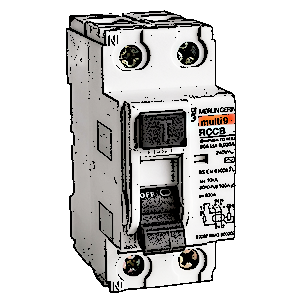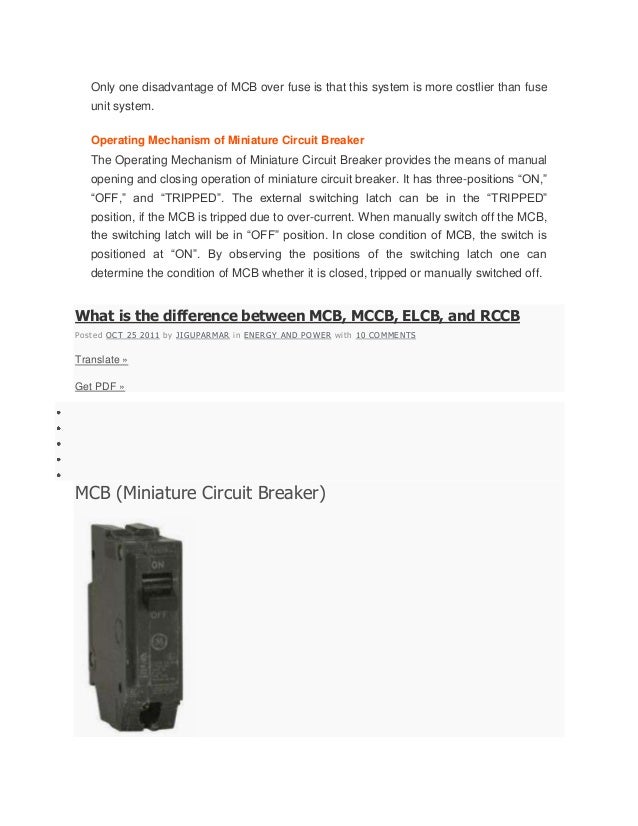
- Difference Between Elcb And Mcb Pdf Reader Online
- Difference Between Elcb And Mcb Pdf Reader Software
Limitation of RCCB. Standard electromechanical RCCBs are designed to operate on normal supply waveforms and cannot be guaranteed to operate where none standard waveforms are generated by loads. The most common is the half wave rectified waveform sometimes called pulsating dc generated by speed control devices, semi conductors, computers and even dimmers. Specially modified RCCBs are available which will operate on normal ac and pulsating dc. RCDs don’t offer protection against current overloads: RCDs detect an imbalance in the live and neutral currents.

A current overload, however large, cannot be detected. It is a frequent cause of problems with novices to replace an MCB in a fuse box with an RCD. This may be done in an attempt to increase shock protection. If a live-neutral fault occurs (a short circuit, or an overload), the RCD won’t trip, and may be damaged.
In practice, the main MCB for the premises will probably trip, or the service fuse, so the situation is unlikely to lead to catastrophe; but it may be inconvenient. It is now possible to get an MCB and and RCD in a single unit, called an RCBO (see below). Replacing an MCB with an RCBO of the same rating is generally safe. Nuisance tripping of RCCB: Sudden changes in electrical load can cause a small, brief current flow to earth, especially in old appliances. RCDs are very sensitive and operate very quickly; they may well trip when the motor of an old freezer switches off. Some equipment is notoriously `leaky’, that is, generate a small, constant current flow to earth. Some types of computer equipment, and large television sets, are widely reported to cause problems.
Difference Between Elcb And Mcb Pdf Reader Online
RCD will not protect against a socket outlet being wired with its live and neutral terminals the wrong way round. RCD will not protect against the overheating that results when conductors are not properly screwed into their terminals. RCD will not protect against live-neutral shocks, because the current in the live and neutral is balanced. Your Maths seems to be in error’. Ohms law is (voltage / resistance) not as you have it “500ohms / 230volts”see the below extract from your text:Quote ” The safest limit of Current which Human Body can withstand is 30mA sec.Suppose Human Body Resistance is 500Ω and Voltage to ground is 230 Volt.The Body current will be 500/230=460mA.Hence ELCB must be operated in 30mASec/460mA = 65msec”Hope you are able to revise accordinglyit strange how so many people missed this error.
On such a basic principle. Dear Jigneshbhai,I stay at Mangalore and I am a layman as far as Electricity is concerned, earlier I was staying at Ahmedabad where the electricity was of good quality. Your article was very informative.Here in Mangalore many times I have noticed that after a power outage when the power returns, there is current in the neutral line. It may be due to faulty re-connection by the electricity linesman. At this time if any appliance is on, it gets fried, also we get a shock on touching the appliance. Some of my appliances were destroyed because of this. I would like to know if I can use Residual circuit device(RCD) to prevent damage to appliances or will a 3 pin adapter with fuse will help.
Or is there any other device that can help prevent damage to appliances when there is current in Neutral( as tested with a screw driver tester). Power outage occurs here at least 3 times a day!!Thanks in advance. RCDs detect an imbalance in the live and neutral currents. A current overload, however large, cannot be detected.
It is a frequent cause of problems with novices to replace an MCB in a fuse box with an RCD. This may be done in an attempt to increase shock protection. If a live-neutral fault occurs (a short circuit, or an overload), the RCD won’t trip, and may be damaged. In practice, the main MCB for the premises will probably trip, or the service fuse, so the situation is unlikely to lead to catastrophe; but it may be inconvenient.It is now possible to get an MCB and and RCD in a single unit, called an RCBO (see below). Replacing an MCB with an RCBO of the same rating is generally safe. The RCCB will operate and cut off supply to the load if there is an unbalance (or difference) in the currents flowing thru the Phase (Line or Live) wire and the Neutral wire.
In the Malaysian system, all equipment and utensils ( esp. Those made of metal), the body or casing is connected to an Earth wire, which originates from the Main Switch Board. In the unlikely event of the Phase wire coming into contact with the body of the appliance (e.g. A bread toaster), a leakage current will flow from the body of the appliance to Earth, causing an unbalance in the RCCB and forcing it to trip and isolate the load.If an Earth wire system is not provided, the RCCB will trip only when a human touches the appliance, causing a current to flow thru him to Earth or Ground, resulting in an unbalance in the RCCB.
Difference Between Elcb And Mcb Pdf Reader Software
An efficient RCCB needs to be sensitive to about 30mA leakage current and operate fast enough to avoid any hazard to the human.Am I right? I believe this is not dangerous as when we use a Test Pen on the Phase wire, a small current does flow thru our body to Earth causing the lamp to light.The doubt is whether the current thru our is the same in both instances.Thank you and hoping for some clarification on this matter.
Thank u v.much Sir. I’ve few doubts.
V r constructing a 2BHK house in Chennai. Can i re-use a 4yr old (was working) 40A AUTO PHASE CHANGER? I also have 25A Rotary phase changers (say RPC) in a box, and in same DB box, 12 LeGrand MCBs (2x c20,4x c16, 2x c10, 4x c6) r there.Shall i connect 3 parts/places(AC1, AC2, & Kitchen) to these RPCs via 63A RCCB in DB & again take back to DB & connect with MCBs?!! So that i can connect confidently all remaining divisions with AUTO-PHASE CHANGER.Also i’ll be glad if i get a chance to talk with you rgdg it. Am not comfortable in txtingThank uSankar TL.
Hi Jignesh I was following through ur various posts on meter bypass. I have a scenario on which I would like ur valuable expert comments. I live in a multi storied government quarter. I would like to know how to bypass the single phase electronic meter. It is giving me sleepless nights. Presently both the live and the neutral from the meter goes to a MCCB which then terminates in our flats DP.One option I am considering is like using 2 wires from one live phase from main connection. One goes through the meter and other directly to the house.
Since distance from the meter to our house is considerable I cannot discreetly lay a new line to the flat I plan to disconnect the neutral in the MCCB and connect the unmetered live wire to the neutral port of the MCCB. In this way 2 wires both having the same phase would be coming to my flat from a single MCCB. We have 2 separate earth connections to the flat. For neutral I plan to use the earth wire. The second earth will be used for the three pin connections so that they are secured. The metered live phase could be used for some very low load to ensure meter running for atleast the minimum units. The unmetered phase will be used for rest of the loads.

My query is-1) Will the MCCB allow 2 live connections through it (both would of same phase so no 440 volts chance)?2) Can I install a MCB with the earth which I would using as neutral. IF so, of how much rating.3) What safety precautions should I take for preventing electrical shocks and equipment safety.Pse reply fast.With regards. @Meter Manageranswers to your query:1) don’t even try to do that. You can’t connect 2 feeder cables to one MCCB. One of the resons is electric shock at the start point of cable although its feeding circuit breaker is disconnected. But, you can connect 2 cables from MCCB and supply 2 or more consumers.2) you can’t do that neither.
If there is a RCD it will trip in that case, and earth conducter must not carry current in normal regime, only in case of fault.3) use appropriate protection (MCB, MCCB, RCD, RCBO, etc), cable sizing to match equipment needs, and use of appropriate IP rating for environment where equipment is installed.
MCCBs MCCBs (Moulded Case Circuit Breakers) are an electrically operated switch designed to protect an electrical circuit from damage caused by overcurrent, typically resulting from an overload or short circuit. How do they work?The basic function of an MCCB is to interrupt current flow after a fault, once the fault is corrected the circuit breaker can be reset (either manually or automatically) to resume normal operation.MCB or MCCBAlthough MCBs and MCCBs both are circuit breakers, there are key differences between the two that make them suitable for specific jobs. The main difference between the two is the capacity, MCBs are rated under 100 amps with an interrupting rating of under 18,000 amps. Consequently, the trip characteristics may not be adjusted since they cater to low circuits. On the other hand, an MCCB comes with an adjustable trip characteristic for the higher loads.
An MCCB would typically provide amps as high as 2500 or as low as 10, depending on the application. The interrupting rating of MCCBs range from around 10,000 amps to 200,000 amps.